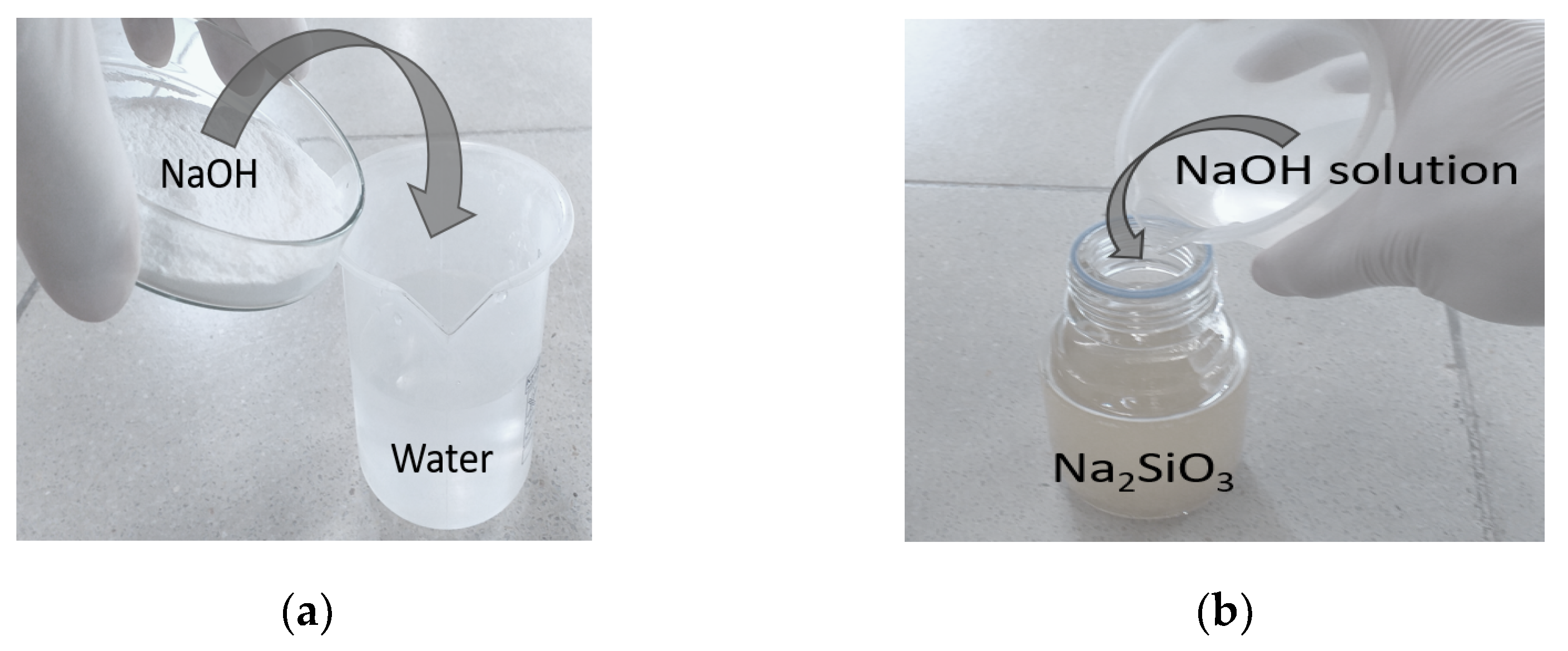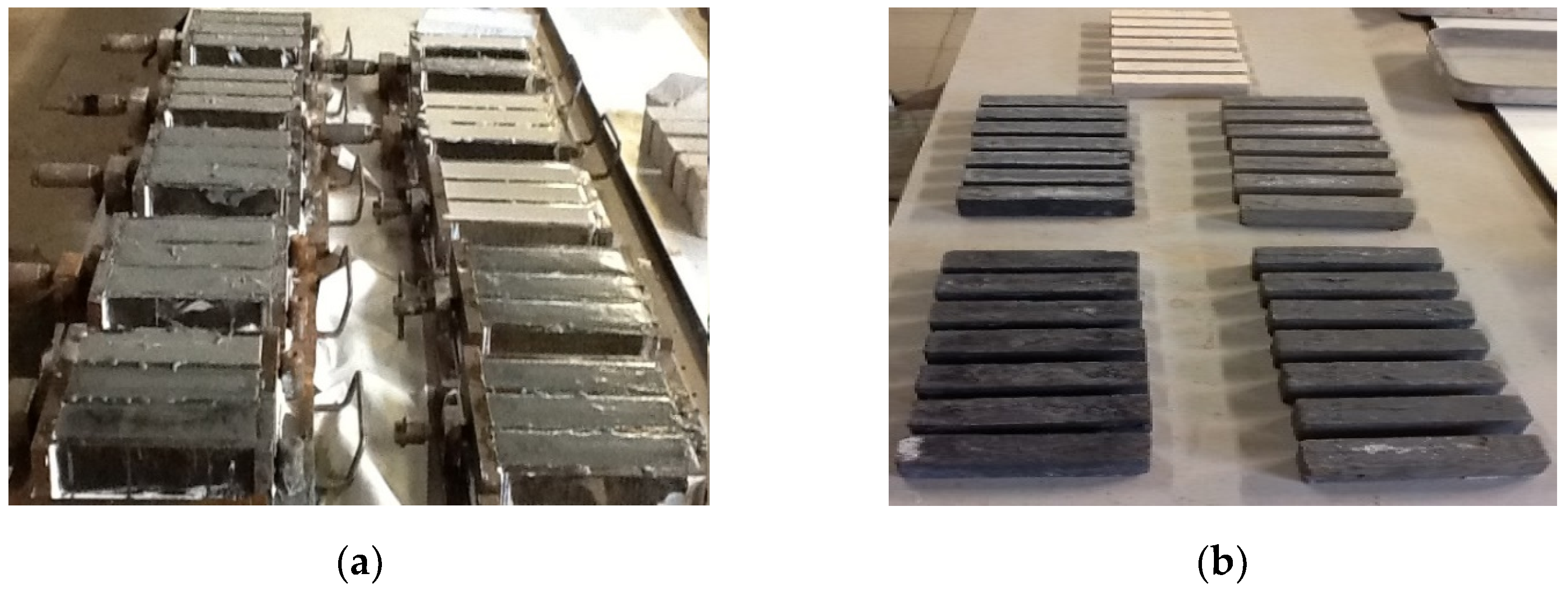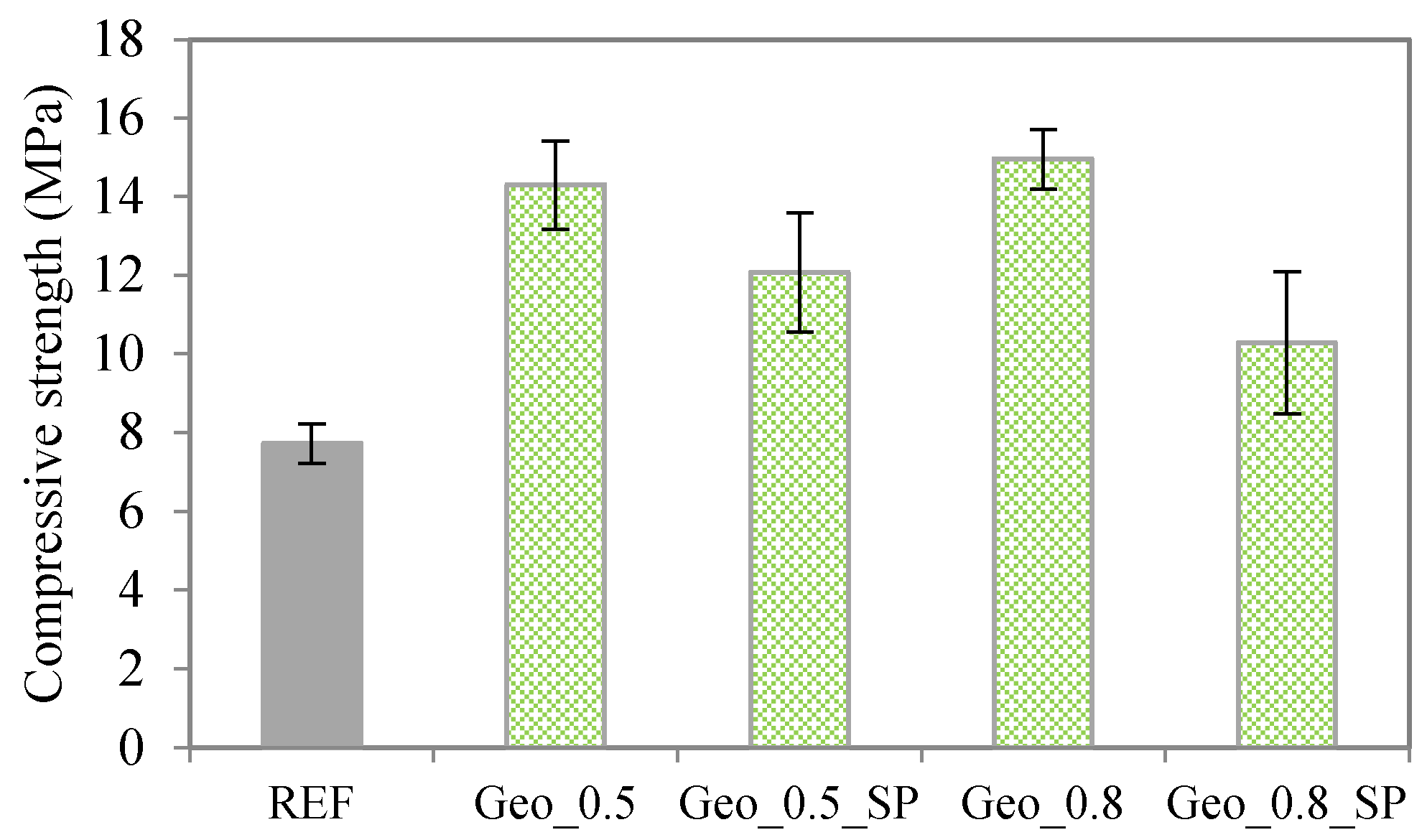Performance of Silica Fume-Based Geopolymer Grouts for Heritage Masonry Consolidation
Abstract
:1. Introduction
2. Experimental Work
2.1. Materials
2.1.1. Silica Fume
2.1.2. Natural Hydraulic Lime
2.1.3. Alkaline Activator
2.1.4. Superplasticizer
2.2. Grout Preparation
2.3. Test Procedures
3. Experimental Results and Discussion
3.1. Rheological Properties
3.2. Physical and Mechanical Properties
4. Conclusions
- From a rheological point of view, geopolymer grouts have poor performance compared to the reference NHL-based grout.
- The presence of SP proved to be beneficial for improving fluidity, which is more noticeable in grouts with AS/SF ratio of 0.5. The grouts with SP showed an increase in porosity values that may be due in part to the entrained air resulting from the presence of the SP.
- It was found that the increase in the content of AS results in higher spread values which are associated with the formation of a less rigid structure, which facilitates the beginning of the grout flow.
- It was also noticed that higher hardened density values were obtained in the grouts with the AS/SF ratio of 0.8, which corroborates the theory that geopolymer microstructure is strongly dependent on the alkali content.
- The compressive strength values obtained at 28 days were in the range of 7.7 to 19.0 MPa, but did not reach values as high as those reported in the literature. This is a consequence of room temperature curing, which delayed the geopolymerization.
- There was an increase of about 90% in the adhesion strength of the geopolymer grout compared to the NHL grout, which is a great benefit. Adhesion is one of the main mechanical requirements in a masonry consolidation intervention.
Funding
Institutional Review Board Statement
Informed Consent Statement
Acknowledgments
Conflicts of Interest
References
- Gartner, E. Industrially interesting approaches to ‘low-CO2’ cements. Cem. Concr. Res. 2004, 34, 1489–1498. [Google Scholar] [CrossRef]
- Huang, L.; Krigsvoll, G.; Johansen, F.; Liu, Y.; Zhang, X. Carbon emission of global construction sector. Renew. Sustain. Energy Reviews 2018, 81, 1906–1916. [Google Scholar] [CrossRef] [Green Version]
- European Commission. 2050 Long-Term Strategy. Available online: https://ec.europa.eu/clima/policies/strategies/2050_en (accessed on 7 January 2022).
- Davidovits, J. Geopolymer cement: A review. Geopolym. Sci. Tech. Geopolym. Inst. Libr. 2013, 21, 1–11. [Google Scholar]
- Shi, C.; Fernández-Jiménez, A.; Palomo, A. New cements for the 21st century: The pursuit of an alternative to Portland cement. Cem. Concr. Res. 2011, 41, 750–763. [Google Scholar] [CrossRef]
- Pagnotta, S.; Tenorio, A.; Tiné, M.; Lezzerini, M. Geopolymers as a potential material for preservation and restoration of Urban Build Heritage: An overview. IOP Conf. Ser. Earth Environ. Sci. 2020, 609, 012057. [Google Scholar] [CrossRef]
- Ricciotti, L.; Molino, A.J.; Roviello, V.; Chianese, E.; Cennamo, P.; Roviello, G. Geopolymer Composites for Potential Applications in Cultural Heritage. Environments 2017, 4, 91. [Google Scholar] [CrossRef] [Green Version]
- Davidovitz, J. Chemistry and Applications, 2nd ed.; Geopolymer Institute: Saint-quentin, France, 2008. [Google Scholar]
- Rangan, V.B. Low-Calcium, Fly Ash-Based Geopolymer Concrete. In Concrete Construction Engineering Handbook; Nawy, E.G., Ed.; CRC Press: Boca Raton, FL, USA, 2008; Chapter 26. [Google Scholar]
- Ryu, G.S.; Lee, Y.B.; Koh, K.T.; Chung, Y.S. The mechanical properties of fly ash-based geopolymer concrete with alkaline activators. Constr. Build. Mater. 2013, 47, 409–418. [Google Scholar] [CrossRef]
- Saxena, S.K.; Kumar, M.; Singh, N.B. The influence of different alkali solutions on the properties of the pond fly ash-based geopolymer mortar cured at different temperatures and under different conditions. Adv. Cem. Res. 2018, 30, 1–7. [Google Scholar] [CrossRef]
- Siyal, A.A.; Azizli, K.A.; Man, Z.; Ullah, H. Effects of parameters on the setting time of fly ash based geopolymers using taguchi method. Procedia Eng. 2016, 148, 302–307. [Google Scholar] [CrossRef] [Green Version]
- Hanjitsuwan, S.; Hunpratub, S.; Thongbai, P.; Maensiri, S.; Sata, V.; Chindaprasirt, P. Effects of NaOH concentrations on physical and electrical properties of high calcium fly ash geopolymer paste. Cem. Concr. Compos. 2014, 45, 9–14. [Google Scholar] [CrossRef]
- Clausi, M.; Tarantino, S.C.; Magnani, L.L.; Riccardi, M.P.; Tedeschi, C.; Zema, M. Metakaolin as a precursor of materials for applications in Cultural Heritage: Geopolymer-based mortars with ornamental stone aggregates. Appl. Clay Sci. 2016, 132–133, 589–599. [Google Scholar] [CrossRef]
- Pagnotta, S.; Tenorio, A.L.; Tinè, M.R.; Lezzerini, M. Geopolymer mortar: Metakaolin-based recipe for cultural heritage application. In Proceedings of the IMEKO TC-4 International Conference on Metrology for Archaeology and Cultural Heritage, Trento, Italy, 22–24 October 2020; pp. 55–59. [Google Scholar]
- Baltazar, L.G.; Henriques, F.M.A.; Temporão, D.; Cidade, M.T. Experimental Assessment of Geopolymer Grouts for Stone Masonry Strengthening. Key Eng. Mater. 2019, 817, 507–513. [Google Scholar] [CrossRef]
- Jorne, F.; Henriques, F.M.A.; Baltazar, L.G. Influence of superplasticizer, temperature, resting time and injection pressure on hydraulic lime grout injectability. Correlation analysis between fresh grout parameters and grout injectability. J. Build. Eng. 2015, 4, 140–151. [Google Scholar] [CrossRef]
- Baltazar, L.G.; Henriques, F.M.A.; Cidade, M.T. Rheology of natural hydraulic lime grouts for conservation of stone masonry influence of compositional and processing parameters. Fluids 2019, 4, 13. [Google Scholar] [CrossRef] [Green Version]
- CEN. EN459-1:2010; Building Lime. Part 1: Definitions, Specifications and Conformity Criteria. CEN: Brussels, Belgium, 2010.
- Phoo-ngernkham, T.; Maegawa, A.; Mishima, N.; Hatanaka, S.; Chindaprasirt, P. Effects of sodium hydroxide and sodium silicate solutions on compressive and shear bond strengths of FA—GBFS geopolymer. Constr. Build. Mater. 2015, 91, 1–8. [Google Scholar] [CrossRef]
- Abdullah, A.; Hussin, K.; Abdullah, M.M.A.B.; Yahya, Z.; Sochacki, W.; Razak, R.A.; Błoch, K.; Fansuri, H. Article the effects of various concentrations of NaOH on the inter-particle gelation of a fly ash geopolymer aggregate. Materials 2021, 14, 1111. [Google Scholar] [CrossRef]
- Rifaai, Y.; Yahia, A.; Mostafa, A.; Aggoun, S.; Kadri, E.H. Rheology of fly ash-based geopolymer: Effect of NaOH concentration. Constr. Build. Mater. 2019, 223, 583–594. [Google Scholar] [CrossRef]
- Jang, J.G.; Lee, N.K.; Lee, H.K. Fresh and hardened properties of alkali-activated fly ash/slag pastes with superplasticizers. Constr. Build. Mater 2014, 50, 169–176. [Google Scholar] [CrossRef]
- Douglas, E.; Brandstetr, J. A preliminary study on the alkali activation of ground granulated blast-furnace slag. Cem. Concr. Res. 1990, 20, 746–756. [Google Scholar] [CrossRef]
- Palacios, M.; Puertas, F. Effect of superplasticizer and shrinkage-reducing admixtures on alkali-activated slag pastes and mortars. Cem. Concr. Res. 2005, 35, 1358–1367. [Google Scholar] [CrossRef]
- Baltazar, L.G.; Henriques, F.M.A.; Cidade, M.T. Grouts with improved durability for masonry consolidation: An experimental study with non-standard specimens. Key Eng. Mater. 2017, 747, 480–487. [Google Scholar] [CrossRef]
- Baltazar, L.G.; Henriques, F.M.A.; Douglas, R.; Cidade, M.T. Experimental characterization of injection grouts incorporating hydrophobic silica fume. J. Mater. Civ. Eng. 2017, 29, 04017167. [Google Scholar] [CrossRef]
- ASTM C939-02. Standard Test Method for Flow of Grout for Preplaced-Aggregate Concrete (Flow Cone Method). Available online: https://www.astm.org/c0939_c0939m-16a.html (accessed on 8 November 2021).
- Baltazar, L.G.; Henriques, F.M.A. Rheology of grouts for masonry injection. Key Eng. Mater. 2015, 624, 283–290. [Google Scholar] [CrossRef]
- Baltazar, L.G.; Henriques, F.M.A.; Cidade, M.T. Experimental study and modeling of rheological and mechanical properties of NHL grouts. J. Mater. Civ. Eng. 2015, 27, 04015055. [Google Scholar] [CrossRef]
- EN 1015-11:1999; Methods of Test for Mortars for Masonry—Part 11: Determination of Flexural and Compressive Strength of Hardened Mortar. CEN, European Committee for Standardization, 1999. Available online: https://standards.iteh.ai/catalog/standards/cen/14596d4c-119b-4a78-94e1-3fe481a29bde/en-1015-11-2019 (accessed on 8 November 2021).
- Provis, J.L. Activating solution chemistry for geopolymers. Geopolym. Struct. Process. Prop. Ind. Appl. 2009, 50–71. [Google Scholar] [CrossRef]
- Favier, A.; Hot, J.; Habert, G.; Roussel, N.; d’Espinose de Lacaillerie, J.-B. Flow properties of MK-based geopolymer pastes. A comparative study with standard Portland cement pastes. Soft Matter 2014, 10, 1134–1141. [Google Scholar] [CrossRef] [PubMed]
- Ma, Y.; Hu, J.; Ye, G. The pore structure and permeability of alkali activated fly ash. Fuel 2013, 104, 771–780. [Google Scholar] [CrossRef]
- Provis, J.L.; Myers, R.J.; White, C.E.; Rose, V.; van Deventer, J.S.J. X-ray microtomography shows pore structure and tortuosity in alkali-activated binders. Cem. Concr. Res. 2012, 42, 855–864. [Google Scholar] [CrossRef]
- Suwan, T.; Fan, M. Effect of manufacturing process on the mechanisms and mechanical properties of fly ash-based geopolymer in ambient curing temperature. Mater. Manuf. Process. 2017, 32, 461–467. [Google Scholar] [CrossRef]
- Valluzzi, M.R.; Porto, F.; Modena, C. Behavior and modeling of strengthened three-leaf stone masonry walls. Mater. Struct. 2004, 37, 184–192. [Google Scholar] [CrossRef]
- Bashar, I.I.; Alengaram, U.J.; Jumaat, M.Z.; Islam, A. The effect of variation of molarity of alkali activator and fine aggregate content on the compressive strength of the fly ash: Palm oil fuel ash based geopolymer mortar. Adv. Mater. Sci. Eng. 2014, 2014, 245473. [Google Scholar] [CrossRef] [Green Version]
- Criado, M.; Fernandez-Jimenez, A.; de la Torre, A.G.; Aranda, M.A.G.; Palomo, A. An XRD study of the effect of the SiO2/Na2O ratio on the alkali activation of fly ash. Cem. Concr. Res. 2007, 37, 671–679. [Google Scholar] [CrossRef]








| Component | SF | NHL |
|---|---|---|
| Al2O3 | 0.15% | 2.00% |
| CaO | 0.20% | 85.00% |
| Fе2O3 | 0.03% | 2.00% |
| MgO | 0.30% | 1.00% |
| MnO | 0.03% | |
| SiO2 | 97.00% | 8.00% |
| SiC | 0.50% | 0.01% |
| SO3 | 1.00% | |
| SrO | 0.05% | |
| K2O | 0.80% | 0.70% |
| Na2O | 0.05% |
| NHL | SF | Water/NHL | AS/SF | SP 1 (%) | |
|---|---|---|---|---|---|
| Ref | ✓ | - | 0.5 | - | 0.3 |
| GEO_0.5 | - | ✓ | - | 0.5 | - |
| GEO_0.5_SP | - | ✓ | - | 0.5 | 0.5 |
| GEO_0.8 | - | ✓ | - | 0.8 | - |
| GEO_0.8_SP | - | ✓ | - | 0.8 | 0.5 |
| Spread Diameter (cm) | Flow Time (s) | |
|---|---|---|
| Ref | 39.8 (±4.0) | 5.2 (±1.5) |
| GEO_0.5 | 14.3 (±1.2) | 94.1 (±5.0) |
| GEO_0.5_SP | 25.6 (±3.5) | 55.3 (±3.0) |
| GEO_0.8 | 31.4 (±1.5) | 41.6 (±2.0) |
| GEO_0.8_SP | 36.5 (±2.0) | 25.3 (±1.8) |
Publisher’s Note: MDPI stays neutral with regard to jurisdictional claims in published maps and institutional affiliations. |
© 2022 by the author. Licensee MDPI, Basel, Switzerland. This article is an open access article distributed under the terms and conditions of the Creative Commons Attribution (CC BY) license (https://creativecommons.org/licenses/by/4.0/).
Share and Cite
Baltazar, L.G. Performance of Silica Fume-Based Geopolymer Grouts for Heritage Masonry Consolidation. Crystals 2022, 12, 288. https://doi.org/10.3390/cryst12020288
Baltazar LG. Performance of Silica Fume-Based Geopolymer Grouts for Heritage Masonry Consolidation. Crystals. 2022; 12(2):288. https://doi.org/10.3390/cryst12020288
Chicago/Turabian StyleBaltazar, Luis G. 2022. "Performance of Silica Fume-Based Geopolymer Grouts for Heritage Masonry Consolidation" Crystals 12, no. 2: 288. https://doi.org/10.3390/cryst12020288
APA StyleBaltazar, L. G. (2022). Performance of Silica Fume-Based Geopolymer Grouts for Heritage Masonry Consolidation. Crystals, 12(2), 288. https://doi.org/10.3390/cryst12020288






